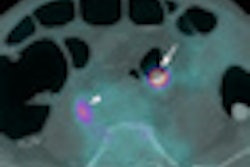
NEW YORK (Reuters Health) - Cerebral emboli on transcranial Doppler ultrasonography (TCD) are markers of an increased risk for stroke in patients with asymptomatic carotid stenosis, investigators reported online Friday in the Lancet Neurology. They also announced their findings last week at the European Stroke Conference in Barcelona.
Compared to symptomatic carotid stenosis, asymptomatic stenosis is relatively benign, with estimates showing that about 32 patients must be treated to prevent one disabling stroke or death over a five-year period. The small absolute benefit raises the question of whether asymptomatic patients should be treated at all.
The data presented this week, which are from the prospective Asymptomatic Carotid Emboli Study (ACES), suggest that TCD can be useful for distinguishing patients with asymptomatic carotid stenosis who are at increased risk of stroke or transient ischemic attack (TIA), and also to identify those at low risk who wouldn't benefit from surgery, according to lead author Dr. Hugh S. Markus, from St. George's University of London, U.K., and colleagues.
It's not time yet for all patients with asymptomatic carotid stenosis to be screened with TCD, however. "This would be reasonable, but before widespread use we need systems that can automatically analyze recordings in real time for the presence of emboli," Dr. Markus told Reuters Health by e-mail. "In ACES we had to do it manually, which takes a long time."
At 26 centers around the world, Dr. Markus and his colleagues recruited 482 patients with asymptomatic carotid stenosis (at least 70%) and studied them with two one-hour TCD recordings from the ipsilateral middle cerebral artery at baseline and one one-hour recording at six, 12 and 18 months.
At baseline, out of 467 patients with at least one recording of sufficient quality, the investigators detected embolic signals in 77. The mean number in those with signals was approximately 2 (range 1-20).
During the next two years, the study cohort had 26 ipsilateral TIAs and six ipsilateral strokes. Four of the TIA patients later had ipsilateral strokes, for a total of 10. Eighteen patients had any stroke, and 37 had any stroke or cardiovascular death.
The absolute annual risk of the primary end point -- ipsilateral TIA or ipsilateral stroke -- was 7.13% in patients with embolic signals and 3.04% inpatients without (hazard ratio 2.39 after adjusting for antiplatelet therapy at baseline).
The annual risks of ipsilateral stroke were 3.62% and 0.70% in patients with and without emboli, respectively (aHR 5.90).
On the other hand, there was no association between embolic signals and risk of any stroke or of any stroke and cardiovascular death.
Controlling for degree of stenosis, age, sex, hypertension, diabetes, and smoking did not significantly alter the results.
The investigators point out that with improvements in medical therapy, surgical intervention for asymptomatic carotid stenosis has a high risk-benefit ratio -- making it more important than ever to be able to identify the patients with most to gain.
By Karla Gale
Lancet Neurol 2010.
Last Updated: 2010-05-28 17:56:18 -0400 (Reuters Health)
Related Reading
Low-cost US device shows promise for carotid screening, April 9, 2010
Copyright © 2010 Reuters Limited. All rights reserved. Republication or redistribution of Reuters content, including by framing or similar means, is expressly prohibited without the prior written consent of Reuters. Reuters shall not be liable for any errors or delays in the content, or for any actions taken in reliance thereon. Reuters and the Reuters sphere logo are registered trademarks and trademarks of the Reuters group of companies around the world.



















